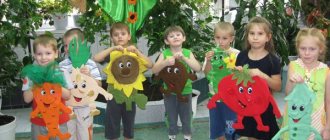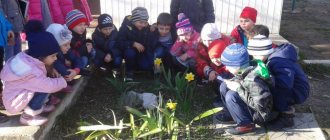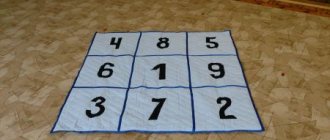Lesson summary “Insects in autumn. Where do mosquitoes hide for the winter and where do they live?
Children very often ask adults: “Where and how do insects winter?” While playing in the fresh air, taking walks in the park or forest, the children notice that with the onset of cold weather, flies, mosquitoes, butterflies, beetles, dragonflies, ants and other insects have disappeared somewhere.
Parents and teachers can tell children that different insects have many ways to survive winter conditions and survive safely until spring. Not only migratory birds fly south, but also some insects, because they also have wings. For example, migratory butterflies include butterflies (thistles, cabbages, whites, admirals, etc.) and dragonflies (large rocker, watchman). These insects fly long distances, not inferior to birds in this regard. It is interesting that the migratory routes of insects almost coincide with the routes of migratory birds, while butterflies and dragonflies successfully overcome mountain passes (Alps, Pamirs), rising to a height of over five kilometers.
With the onset of cold weather (late autumn and then winter), insects fall into torpor, stop feeding, lose mobility and spend the winter in a state of hidden life. In the spring, they seem to awaken and begin to live as before. They can therefore be called “passive winterers.”
Due to the large number and diversity of insects, we will dwell on only a few of them. Most butterflies (not counting migratory species) die before the onset of winter. But the females leave behind clutches of eggs from which caterpillars develop. Some of them manage to turn into pupae in the summer, others remain to spend the winter in different shelters: some hide in the ground, and others in spider web nests on tree branches. However, among adult butterflies there are wintering ones that do not die, but fall into torpor. These include: urticaria, lemongrass, mourning grass, multiflora, daytime peacock's eye. In late autumn, these butterflies climb under fallen leaves, into cracks in the roots of old stumps, under the bark of trees and in other secluded places. After overwintering, they leave their “shelters” and fly for some time, feeding on plant nectar. Then the females lay eggs and die, and a new generation of butterflies, developing from the eggs (through the caterpillar stage), appears in the second half of summer and flies until autumn. In winter, butterflies of this generation fall into torpor, and in the spring they behave like butterflies of the previous generation.
In winter, beetles and their larvae sleep in a torpored state in various shelters: some - under the bark of half-rotten stumps, others - in cracks in tree trunks, others - in the thickness of wood, etc. Children know a lot of beetles: ground beetles, dung beetles, longhorn beetles, bark beetles, leaf beetles. But the most famous are the May beetles. The appearance of these beetles in the spring occurs suddenly and causes bewilderment in children: where did they come from? Without going into details, we can say that for most of their life (4-5 years) chafers live in the soil in the form of larvae. From year to year, these larvae overwinter, grow, molt, and eventually turn into pupae, from which adult beetles emerge. May beetles and their larvae cause harm by gnawing the roots and foliage of many forest trees. Ladybugs hide between the needles of young pine trees and among the leaves of juniper. In preparation for the coming winter, they tend to hide in advance under the bark of trees, cracks in old wood stumps and other shelters, where they remain in the torpor stage until spring.
Remind children to respect all living things. Don't let them catch and collect butterflies and bugs. We must not forget about the beneficial significance or harmlessness of the existence of animals. For example, butterflies of autumn broods in the caterpillar stage feed on weeds and do no harm, and the butterflies themselves contribute to the pollination of flowering plants. Ladybird beetles and their larvae destroy a lot of aphids that cause harm to many plants.
Dragonflies are also very useful. They catch flies, mosquitoes, midges and other insects, grabbing them in flight. By winter, most dragonflies (excluding migratory species) die, having previously laid eggs in the water. True, the dragonfly does not die, but hibernates and only lays eggs in the spring. The eggs hatch into larvae that live in water for 2-3 years and gradually grow. In the last year of development, the larva turns into an adult dragonfly, the emergence of which occurs in some in the spring, in others in the summer.
Ants dig themselves a shelter from frost at a depth of over a meter, where the temperature always remains at approximately the same level; Having gathered in a large ball, they wait for the onset of warm days.
Bees do not sleep in winter, but become slow and lethargic. In nature, bees settle in tree hollows and rock crevices. They build their nests from wax secreted by special glands. The nests exist for many years, and females and worker bees spend the winter in them. Therefore, honey is stored in wax cells for nutrition, while larvae hatch in others. The role of bees on Earth is extremely great - collecting nectar, they pollinate plant branches, carrying pollen. Without such pollinators, many modern plants would cease to exist.
Download:
Development of an open lesson “Insects in autumn.”
Ants
- excellent builders.
What wonderful anthill houses they build! Is an anthill a multi-story building? warm, cozy, with good ventilation, with storage rooms, with bedrooms, with children's rooms, with a garbage disposal and a toilet. Ants keep their homes perfectly clean. All entrances and exits allow fresh air to pass deep into the anthill. All these entrances and exits are guarded by soldier ants. From above, the ants make a covering of needles and twigs on the anthill. It protects the home from the vicissitudes of the weather, and is repaired and updated by working ants. Ants feed on fruit pulp, seeds, nuts, plant rhizomes, tree sap, honeydew. Ants are beneficial insects . They are very small and very hardworking. They are called "forest orderlies." In one day they destroy a large number of harmful insects . They hibernate in an anthill, closing all the entrances and exits
- a riddle
The housewife will fly over the lawn, fuss over the flower - He will share the honey. (bee)
Bees
- bright honey-bearing insects. The bee has a very beautiful striped yellow and black color. She has wings and a proboscis. She uses it to suck nectar from plants and turn it into honey. This is a healthy and very tasty delicacy. Bees feed on plant pollen and nectar. Bees that live next to humans, in apiaries, also feed on sugar syrups specially prepared for them.
Bees, like ants, live in large friendly families - from 10 to 70 thousand individuals. Each family member has their own responsibilities. For example, the queen - a kind of queen bee - is engaged in laying eggs. In a bee family there are many worker bees - honey producers. Worker bees not only collect nectar, but also clean the territory, protect their home and feed their children. There are large bee families and completely useless bees that do not bring any benefit to the family. They are called drones. A person who breeds bees is called a beekeeper or beekeeper, the place where he breeds bees is called an apiary, and the houses that he makes specifically for bees are called hives. The hive will survive the winter
.
1.
Physical exercise
In the morning, the Bee woke up, smiled, stretched, Once, she washed herself with dew, Two, she spun gracefully, Three, she bent down and sat down, Four, she flew away.
2.
Riddle
Not a beast, not a bird - The nose is like a knitting needle. It flies - it squeaks, it sits - it is silent. Whoever kills him will shed his blood (mosquito)
Mosquito
More than 2 thousand species of mosquitoes live on our planet.
The mosquito has a proboscis with which it pierces the skin and releases poisonous saliva under the skin. This is why the skin itches and itches after a bite. Mosquitoes are active in the evening.
At one time, a female mosquito drinks blood 5–6 times its weight. Many people think that mosquitoes squeak, but we hear the sound of mosquito wings.
Many mosquitoes carry very dangerous diseases when they bite people.
The most famous mosquito hunters are frogs and toads, as well as birds: wagtails, tits, sparrows. In winter they sleep.
mystery
Who walks above us upside down - is not afraid, is not afraid of falling, flies all day long, is everyone bored? (fly)
Fly
Very often flies come to visit us without an invitation.
They have two large eyes, they consist of many small facet eyes. The fly has a good sense of smell thanks to its short but fluffy antennae. There are about five thousand species of flies in total. We usually see a housefly. She is very dangerous and carries various dangerous diseases. One fly carries up to 6 million microbes. Special pads on its feet help the fly crawl on smooth surfaces. Fortunately, flies have many enemies in nature: frogs, birds: wagtails, tits, sparrows .
Flies also sleep in secluded places. Mystery
The flower was sleeping and suddenly woke up -
I didn't want to sleep anymore.
He moved, he started,
He soared up and flew away.
The most beautiful, most elegant insects are butterflies. As soon as the sun warms up and the flowers bloom, they begin to flutter from flower to flower and catch your eye with their bright colors.
Most butterflies
happens in May and June.
They mainly feed on pollen and nectar of flowering plants. Most species consume tree sap, rotting and overripe fruit. But it turns out that a butterfly doesn’t always look like this. Butterfly development cycle
: A butterfly lays eggs, from which caterpillars emerge. When the caterpillar is full, it wraps itself in sticky web and becomes a cocoon or pupa. Inside the cocoon, the caterpillar turns into a beautiful butterfly.
Butterflies are generally useful; they pollinate plants.
But there are also harmful butterflies. Cabbage butterfly, moth.
Some butterflies have frightening colors.
In nature, there is a wide variety of butterflies in color.
3.
Conclusion
Guys, in the fall all insects hide in secluded places
, under the bark of trees, in crevices of the bark, old stumps, under leaves, some fly into the attics of houses, into the rooms of houses, sleep in indoor flowers, for example
4.
Reflection
D idactic game “ Finish the sentence”
Bee...collects honey Fly...spreads germs Grasshopper...chirps with its wing covers Ant is...an orderly for the forest Mosquito...drinks blood butterfly feeds...on nectar of flowers Ladybug...destroys aphids
Express test “Helpful-harmful”
5.
Summary of the lesson
What new did you learn today? Did you enjoy the lesson? Choose a mood butterfly... what mood do you feel after class (good, colorful)
Literature:
1. Brykina N.T., Zhirenko O.E. Non-standard and integrated lessons in the course “The World around us”. - M, “Wako”, 2014
2. Vasiliev Yu.R. Entertaining natural history. - M, “Omega”, 2017
3. Lyashenko School of young local historian. - Volgograd “Teacher”, 2015
4. Pekpaev A.A. Native land. Y-Ola, Mari Book Publishing House, 2012
5. Pekpaev A. A We study nature. Y-Ola, Mari Book Publishing House, 2015
6.Petrov V.V. Flora of our Motherland. – M, “Enlightenment”, 2016
7. Encyclopedia of secrets and mysteries of the Wonders of living nature. - M, “White City”, 2014
8. Encyclopedia I explore the world. – M, “Astrel”, 2014
9.Encyclopedia "Plants", M, 2021
Moved by the flower




